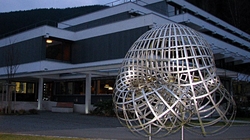
The Mathematisches Forschungsinstitut Oberwolfach is an international research center situated in the German Black Forest. It has one of the best mathematical libraries in the world, and is famous for their seminars, conferences, and mathematical gatherings.
The first time I heard about MFO was when I collaborated with the Exhibition Imaginary/BCN, in Barcelona; this exhibition started in MFO, after Herwig Hauser created a series of beautiful pictures of algebraic surfaces with interesting mathematical structures, with the goal to catch the attention of prospective PhD students; later, the pictures became part of a very nice exhibition, that has already travelled to many cities from around the world!
It was a big surprise when I saw that the director of the MFO, Professor Gerhard Huisken, together with Professor Simon Brendle (from Stanford University), organized one of the Oberwolfach Seminars on Singularity Analysis for Geometric Flows, a topic in which I am very interested (it is essentially the field of my PhD thesis). So I didn't doubt about it, and I showed my interest in attending the seminar.
The first time I heard about MFO was when I collaborated with the Exhibition Imaginary/BCN, in Barcelona; this exhibition started in MFO, after Herwig Hauser created a series of beautiful pictures of algebraic surfaces with interesting mathematical structures, with the goal to catch the attention of prospective PhD students; later, the pictures became part of a very nice exhibition, that has already travelled to many cities from around the world!
It was a big surprise when I saw that the director of the MFO, Professor Gerhard Huisken, together with Professor Simon Brendle (from Stanford University), organized one of the Oberwolfach Seminars on Singularity Analysis for Geometric Flows, a topic in which I am very interested (it is essentially the field of my PhD thesis). So I didn't doubt about it, and I showed my interest in attending the seminar.
MFO offered me funding to attend the seminar, and I am very excited about it! I am sure that it will help me a lot to develop my understanding on this field! So, it looks like I am visiting Oberwolfach in September.
Thank you MFO!
Singularity Analysis for Geometric Flows
What does that even mean? Well, let me try to explain it, without going into too much detail. Geometric Flows are differential equations that appear in a geometric setting, usually involving geometric concepts such as the curvature of a surface or a curve (or a geometric object of higher dimension). One example is the Curve Shortening Flow (a particular case of the Mean Curvature Flow), were the shape of a curve evolves with respect to a parameter (say time) depending on its curvature: in the regions where the curve has a high curvature, it evolves fast, moving in the normal direction to the curve, while in the flat regions it almost doesn't move. You can see an example in the following video:
Thank you MFO!
Singularity Analysis for Geometric Flows
What does that even mean? Well, let me try to explain it, without going into too much detail. Geometric Flows are differential equations that appear in a geometric setting, usually involving geometric concepts such as the curvature of a surface or a curve (or a geometric object of higher dimension). One example is the Curve Shortening Flow (a particular case of the Mean Curvature Flow), were the shape of a curve evolves with respect to a parameter (say time) depending on its curvature: in the regions where the curve has a high curvature, it evolves fast, moving in the normal direction to the curve, while in the flat regions it almost doesn't move. You can see an example in the following video:
As it is shown in the video above, sometimes the curves might shrink to a point; similarly, when dealing with a surface, the whole surface, or just a curve in it, might shrink to a point. When this happens, we say that the flow has encountered a singularity. It turns out that studying how the flow evolves if we "forget" about these singularities, by keeping them under control, might bring us to interesting information about the initial curve that we were studying. This was shown, for instance, by Grigori Perelman, who used the analysis of singularities in the Ricci flow to prove the Geometrization Conjecture and the Poincaré Conjecture, a major problem in mathematics that was worth 1,000,000$. Here is a video of the evolution of the surface of a peanut under the Ricci flow:
Well, I think that this is enough for today, although that I will definitely talk more about geometric flows in the future (with more detail!), and I will share with you my experience in Oberwolfach. If you would like to know a little bit more about geometric flows and the Poincaré conjecture, you might find the following video very interesting! If you want to learn it seriously, you can look for Professor Huisken's lectures on the Mean Curvature Flow on Youtube, I found them very enlightening!
 RSS Feed
RSS Feed
